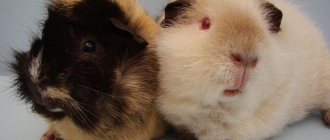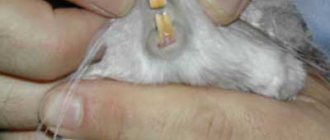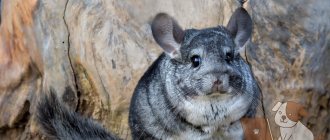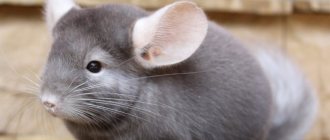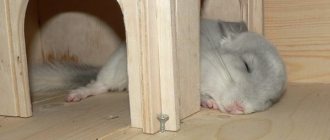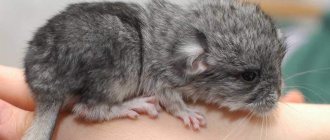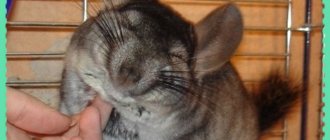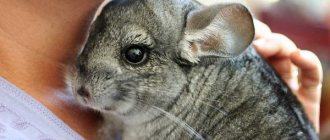The chinchilla is considered one of the most popular pets. The unusual rodent immediately becomes a favorite of its owners. Unfortunately, sometimes a tragedy occurs in a family - a healthy-looking chinchilla suddenly dies. Pet owners are beginning to wonder what could cause the death of an animal living at home? The most common causes of pet death are errors in feeding and keeping a chinchilla, as well as advanced diseases that were not noticed by the owners in time.
Chinchillas can live up to 25 years
Intestinal parasites
Infection with worms is quite common and is epidemic in nature. A small infection may be invisible to the owner and the animal may not show signs of concern. However, if there are a lot of parasites, this leads to noticeable weight loss, frequent digestive problems, and parasite eggs can be found in feces. It is recommended to treat with Furazolidone. One tablet is crushed and added to the drinking bowl.
The course of treatment is ten days. At the same time, the animals must be given Nemozol through a syringe - 15 ml per kilogram of live weight. The medicine is given twice a day for a week and repeated after ten days.
During treatment, careful cleaning and treatment of the cage is necessary.
Stomatitis
Chinchilla diseases are often infectious. One of the most common infectious diseases is stomatitis.
Stomatitis in chinchillas is most often caused by a viral, bacterial or fungal infection, and the cause is a weakened immune system, lack of iron in the body, or severe infestation with worms.
Symptoms are increased salivation, constantly wet fur around the mouth and on the chest, refusal to eat, strong and unpleasant breath. What should you do if you notice these signs? Stomatitis must be treated by treating the animal’s oral cavity three to four times a day with Metrogildent or Lugol. It is also recommended to rinse the chinchilla's mouth with Chlorhexidine.
Infectious stomatitis in chinchillas
Chinchilla diseases - symptoms and treatment
Poisoning
Poisoning can happen if a chinchilla eats unsuitable food or food that is not suitable for it.
In case of poisoning, the animal may refuse to eat; At the same time, the chinchilla is lethargic and weakly active. Drooling is common.
In case of serious poisoning, treatment, unfortunately, is not always effective - but timely action will help increase the chances of curing the chinchilla.
Possible remedies that will help with chinchilla poisoning:
- enterosgel
- gamovite
- catozal (to speed up metabolism)
- traumeel
To prevent dehydration, you can administer saline solution in a dosage of 10 ml, as well as glucose solution.
Lichen
It is an unpleasant scourge for any animal, and chinchillas are no exception.
With this disease, areas appear on the body where hair is partially or completely absent. In this case, irritation may occur in such areas. It often happens that the first manifestations of lichen are found in the area of the animal’s nose and ears.
Hair loss in chinchillas can be caused by various parasites. If you live in a city, it is advisable to scrape the affected area of skin. A specialized laboratory will help identify not only the parasite itself, but also select a drug that will effectively deal with it.
If your city does not have a specialized laboratory where such an analysis can be performed, you can use broad-spectrum drugs.
It is possible to use the following drugs in the treatment of this chinchilla disease:
- Vakderm-F – injections of 0.3 ml with an interval of 1-2 weeks. The drug can only be used for adults, because it can slow down or completely stop the animal's growth process. Use is permitted for chinchillas from 6 months of age.
- Lamisil and Exoderil - suitable for both adult animals and small chinchillas. The affected areas of the body are treated with a spray twice a day for 14 days.
It should be noted that lichen is a highly contagious disease. Therefore, a chinchilla that has been diagnosed with lichen should be isolated from other individuals and any contact should be excluded - a quarantine regime is appropriate. To minimize the likelihood of infection with lichen, you can use fungistol, and it is also necessary to carry out regular hygiene of rooms and cells. Using a bactericidal lamp will not hurt.
Conjunctivitis
Bacterial inflammation in the eye area occurs quite often in chinchillas. In this case, the animal will experience discharge, which, depending on the extent of the process, can be scanty or abundant; sometimes purulent contents may be discharged. For a bacterial infection, antibiotics can be used for treatment.
In general, the following remedies can be used to treat conjunctivitis and inflammation of the eye area in chinchillas:
- ointments – tetracycline, hydrocortisone
- Maxidin drops
- colloidal silver rinsing
- in case of damage to the cornea, clouding of the vitreous body, it is possible to use an already proven product - Taufon drops (or analogues)
Bites
Sometimes these rodents can be aggressive. Chinchillas do not always manage to get along with each other. This is a sure way to cause injuries, scratches, bites, and abrasions. Bites can be superficial or deep.
For large wounds, you need to immediately begin helping the animal. Take him to a place where he will be protected from the encroachments of other individuals - provide the chinchilla with maximum peace. It is advisable to clean the damage from blood, and treat the wounds with hydrogen peroxide and Levomekol. Injections of Catozal and Traumeel will speed up the recovery of the body.
It happens that with strong bites the animal refuses food. In this case, you need to administer saline and glucose. Moreover, vitamins can also be diluted in the latter to maintain the animal’s strength. If this works, you need to force-feed the chinchilla; if not, be sure to continue using glucose in combination with saline solution.
Chinchillas often bite and damage each other when mating. Therefore, it is better that someone is at home at this time, and if aggression occurs, the animals should be immediately placed in different cages.
Invasion
For chinchillas, infestation is a serious disease. When infested, a chinchilla may refuse to eat, and its behavior will become lethargic, apathetic, and weakly active. The chinchilla may develop severe bloody diarrhea. In case of invasion, it is possible to perform a complex surgical operation to remove the affected part of the intestine, but the likelihood of a positive outcome is low.
Diarrhea
For diarrhea in chinchillas, it is possible to use oak bark, as well as medicines - Smecta, Linex. It is important to stop the dehydration process - therapeutic measures must be started quickly. During treatment, the animal's diet should consist primarily of hay and liquid.
The cause of chinchilla diarrhea can also be previous treatment with antibiotics - often after completing a course of drugs, dysbiosis develops in the intestines. You can restore normal intestinal functioning by using boluses from a healthy animal.
Constipation
When constipated, a chinchilla's belly is swollen, the animal experiences weakness, and the boluses are small. In such a situation, the main task is to restore intestinal motility. For this purpose, the animal should walk a lot, but it is also possible to use a number of therapeutic agents:
- Vaseline oil - given to drink several times a day or injected into the rectum using a syringe
- in severe cases, the use of Cerucal injections is justified
The possibility of a chinchilla swallowing its own hair with the formation of clots and, as a result, intestinal obstruction has not been proven in chinchillas - however, if there is suspicion, the use of Malt paste is possible.
Rectal prolapse
This problem in chinchillas in most cases is a direct consequence of constipation, the manifestations of which were described above. Constantly straining to have a bowel movement eventually leads to bowel prolapse. In this case, part of the bloody intestine (usually no more than 2-3 cm long) comes out of the anus.
In case of prolapse of part of the intestine, restoration measures must be started as soon as possible, otherwise necrosis of the prolapsed area is possible. For self-reduction, the prolapsed area must be lubricated with ointment and then adjusted using a thermometer. After a few days, the chinchilla should have a bowel movement.
It is better to trust intestinal adjustments to experienced veterinarians and not to do them yourself - this procedure requires some skill.
Dental diseases
Dental diseases are also common in chinchillas. At the same time, their color changes, and the animal may develop “drooling” when the teeth grow incorrectly. At the same time, sometimes the chinchilla is wet in the neck area. If it progresses, the teeth may take on an unsightly shape. The skin on the animal's face may also be damaged.
It is easier to deal with the problem in the early stages. It is not always possible to cure a neglected process.
For treatment, special feeds enriched with phosphorus compounds are used, and vitamins must be added to the diet. It is possible to add sodium phosphate in powder form to the feed.
If a chinchilla has lost a tooth, the place where it fell out can be treated with Metrogyl Dent gel.
Inflammation of the feet
Inflammation of the feet sometimes occurs in chinchillas, and in most cases the hind legs are affected. If this condition is not treated, surgery may be required in the future. To treat pododermatitis, special medications are used, which a veterinarian will help you choose.
Colds
A chinchilla can get a cold. An animal’s body temperature is dangerous at about 38 °C, and at 39 °C there is a risk to the chinchilla’s life. When a chinchilla has a cold, they often develop a severe runny nose.
To speed up recovery, you need to insulate the place where the animal is, eliminate possible drafts, and clean the nest from dust. Also an important factor in a quick recovery is enhanced nutrition.
Urinary system disease
Cystitis usually affects adults. Both males and females are equally susceptible to the disease. The first signs of cystitis are problems with urination, anxiety, the animal bites its sides, squeaks often, and becomes inactive. If signs of illness appear, you should immediately consult a doctor. Self-treatment of the disease without prior examination can only harm the animal. Very often, the internal cause of cystitis is sand or even kidney stones.
Salmonellosis
Salmonellosis is one of the most dangerous, but not so common, diseases of chinchillas. The danger is that the disease is transmitted to humans. The source of the disease is food or water contaminated with bacteria. The disease can occur in two forms:
- Spicy,
- Chronic.
In the first case, signs of the disease: severe diarrhea, refusal to eat, rapid weight loss. Treatment of the acute form of salmonellosis rarely brings positive results - the animal dies from exhaustion within a few days and most veterinarians, having diagnosed the disease, advise euthanizing the pet. The chronic form can develop over a long time, periodically accompanied by severe diarrhea and apathy, refusal to eat, and anxiety. Diagnosis of the disease in the chronic stage can only be done by testing for resistance. Treatment is prescribed by a veterinarian depending on the severity of the disease and the condition of the animal.
Self-treatment is more likely to lead to the death of the chinchilla.
What can a chinchilla die from?
from
Mikhail Konovalov 05/08/2019, 19:43
574 Views
People tend to become attached to their pets, including chinchillas. Unfortunately, there are situations when a seemingly absolutely healthy individual can suddenly die, and this becomes a tragedy. The question arises - what causes chinchillas to die at home? This is important to know, because perhaps you are able to save your pet from death.
Colds
If a chinchilla sneezes, becomes lethargic, mucus comes out of its nose, and its body temperature is noticeably elevated, the animal has a common cold. The disease is not so harmless - improper treatment or untimely provision of assistance can result in death. Colds most often occur as a result of hypothermia or after being exposed to a draft. Treatment consists of a course of antibiotics for five days, as well as an abundance of succulent food rich in vitamins, additional ascorbic acid dissolved in warm water, an insulated house and complete rest.
Allergy
A chinchilla's runny nose can also be caused by an allergic reaction to dust, bedding or hay. With allergies, a chinchilla sneezes, often rubs its nose with its paws, and there may be eyelid swelling and difficulty breathing. Treatment of chinchillas for allergies consists of completely eliminating the allergen: replace the hay and bedding, rinse the cage thoroughly, change the water, and return all the usual food. Among medications, Suprastin has proven itself well.
However, most often, cleaning the cage and eliminating the allergen from the animal’s environment is enough.
Conjunctivitis
At home, eye disease in chinchillas is quite common. Conjunctivitis can manifest itself in suppuration, hyperemia, and severe lacrimation. The animal may become apathetic, scratch its eyes, and eat poorly. The cause of the disease is poor living conditions. Dirty bedding, dusty food, an uncleaned cage - all this leads to conjunctivitis. Improper treatment can lead to the development of cataracts, so you should consult a doctor to determine the severity of the inflammation. Most often, the doctor prescribes ointments or eye drops containing an antibiotic for treatment. The composition of the antibiotic is determined based on tests, but drops such as Tsiprovet and Dia-Levomethicin have a wide spectrum of action and help in most cases.
Chinchilla is dying: causes and signs
The chinchilla is considered one of the most popular pets. The unusual rodent immediately becomes a favorite of its owners. Unfortunately, sometimes a tragedy occurs in a family - a healthy-looking chinchilla suddenly dies. Pet owners are beginning to wonder what could cause the death of an animal living at home? The most common causes of pet death are errors in feeding and keeping a chinchilla, as well as advanced diseases that were not noticed by the owners in time.
Convulsions
Sudden convulsions in chinchillas are a common and quite dangerous ailment.
Seizures in chinchillas can be short-term or last for several hours. Chinchilla convulsions look like a chaotic shaking of the whole body, during which the ears are tight to the head and the paws are completely paralyzed. Breathing becomes heavy and intermittent. The most common reason is a lack of calcium or vitamin B in the animal’s body. Seizures in chinchillas also occur as a result of a drop in sugar levels. First aid for an animal:
- Give your pet a piece of date or raisin,
- Intramuscularly administer Dexamethasone - 0.2 ml, or Prednisolone with liquid calcium and glucose,
- Rub your paws and do a light tummy massage (to avoid constipation),
- Examine the animal - often convulsions can cause bruises, fractures, severe sprains,
- Place your pet in a warmer place.
- As soon as the animal returns to normal, you must immediately contact a veterinarian!
If during convulsions a chinchilla lies on its side, breathes heavily and hoarsely, and blood comes out of its mouth, the animal will soon die, since the convulsions have provoked interruptions in the functioning of the heart and even the veterinarian will be powerless.
Prevention of seizures is the constant presence in the animal’s diet of dried fruits, as well as vitamins and minerals: calcium, B vitamins, magnesium and phosphorus.
Stroke
Frequently recurring seizures in chinchillas may indicate a stroke. Understanding the difference between seizures caused by vitamin deficiencies and strokes is difficult, but necessary. Secondary symptoms of stroke are:
- Temporary paralysis of one side of the body,
- Loss of orientation associated with a sharp deterioration in vision,
- The animal does not respond to external stimuli,
- Profuse salivation.
If dangerous symptoms are detected, you should immediately consult a doctor. Drugs and dosage for the treatment of stroke in chinchillas are prescribed only after a full examination, and in most cases chinchillas die quite quickly from self-treatment.
Causes of chinchilla death
There are several reasons why a chinchilla dies prematurely.
Heatstroke
South American rodents have difficulty withstanding air temperatures above 25 degrees Celsius. She poses a mortal danger to them.
Important! The optimal temperature for a chinchilla to live is 18-20 degrees Celsius with a relative humidity of about 60 percent.
If heatstroke is suspected, the chinchilla should be moved as soon as possible to a cool, draft-free place.
To avoid heat stroke, chinchilla owners must take care of favorable conditions for keeping the animal. To do this, use air conditioners to cool the room and humidifiers or sprayers to humidify the air.
Stress
Surprisingly, chinchillas, like people, are susceptible to stress. It is stress that quite often leads to tragic consequences.
Important! Chinchillas are very emotional rodents. Any strong fear can lead to instant cardiac arrest.
Stressful situations can be caused by:
- sharp and loud sounds;
- excessive attention from other larger pets or children;
- change of scenery. Adults perceive it especially acutely;
- falling from a height;
- careless handling or shouting of the owner.
In order not to expose the chinchilla to stress, the place where it should be kept should be a room with a quiet, calm environment, where pets and children do not have unsupervised access.
Poisoning
One of the most common causes of death in pets is poisoning, especially if the animal roams freely. The subject of poisoning can be table salt, indoor plants, household chemicals, spoiled food and hay.
Intoxication causes diarrhea, vomiting, drooling, loss of coordination and convulsions. You can help the animal with gastric lavage and an enema. Unfortunately, in some cases the animal will die instantly and cannot be saved.
To prevent chinchilla poisoning, it is necessary to remove dangerous objects and products out of the reach of your pet and carefully monitor the expiration date indicated on the food. If there are poisonous plants, you need to limit the chinchilla's access to the rooms where they are located.
Bloating can occur due to spoiled food
Bloating
Often a small animal dies due to bloating occurring in the stomach or intestines. Bloating occurs when a chinchilla consumes:
- spoiled hay;
- fresh grass;
- cabbage;
- apples in large quantities;
- carrots in large quantities;
- poor quality water.
The gastrointestinal tract undergoes fermentation of gases, causing the intestines or stomach to swell. The chinchilla is in severe pain. If you do not notice the pathology and do not help your pet in time, it will die.
You can provide first aid to the animal using carminatives and abdominal massage.
In order not to subject your chinchilla to such suffering, it is necessary to carefully monitor the quality of food and water, not to overfeed your pet, not to feed it inappropriate food, and also to prevent the animal from voluntarily eating this or that product.
Cold
If the animal is kept in places where there are constant drafts, this can lead to colds. When an animal has a cold, there is discharge from the nose and eyes, weakness, refusal to feed, and an increase in body temperature.
Important! An increase in temperature above 39 degrees leads to the death of the chinchilla.
Self-medication of a cold in a chinchilla can lead to dire consequences. Therefore, you should entrust the treatment of your pet exclusively to a veterinarian. He will prescribe antibacterial drugs, rosehip syrup, and symptomatic remedies.
To avoid colds in your chinchilla, you need to keep it away from drafts and cold.
Stroke
Sudden death of a chinchilla can be caused by a stroke. The causes of stroke are:
- severe fear;
- head injury;
- poisoning;
- sudden changes in temperature;
- lack of vitamins B.
A stroke in a pet can be determined by the following signs:
- the animal falls on its side;
- the hind legs are paralyzed;
- There is profuse salivation.
If you notice a seizure in a chinchilla, you need to inject drugs such as dexamethasone and traumatin.
Important! After providing first aid to a chinchilla for a stroke, you need to contact a veterinarian as soon as possible.
You can determine that an animal is sick by some changes in its behavior.
Skin diseases
Ringworm is the most common skin disease in chinchillas, caused by improper living conditions, vitamin deficiency or contact with a sick animal. Some forms of lichen can be transmitted to humans, so before treatment it is recommended to do a skin scraping to determine the type of fungus. It is quite simple to understand that a chinchilla has become infected with lichen: the animal is constantly itching, there is hair loss and the formation of bald patches covered with a dry, flaky crust. Vakderm is most often used for treatment. The drug is injected intramuscularly, 2 ml into the thigh area once a day, the procedure is repeated every week until complete recovery.
A good prevention of any skin diseases is adding the drug Fungistop to the sand for swimming. Fungistop is an effective and safe antifungal and antibacterial drug. Fungistop contains non-toxic medical sulfur. Application - one teaspoon of Fungistop is mixed with bathing sand and filled into the bath. The bath is placed in the cage twice a week for an hour or two. If the animal is an exhibition animal, then it is recommended to bathe the animal in a bath with sand and Fungistop before each trip, since very often animals become infected with lichen spores in public places.
How does a chinchilla die?
The owner of an unusual rodent needs to be very attentive to his beloved pets, know the character and usual behavior of the cheerful animal in order to help his little friend in time. A healthy animal is active, has shiny, dry eyes; the animal enjoys its favorite treats and responds to the owner’s affection. The owner can understand that a chinchilla is dying by characteristic symptoms:
- lack of coordination of movement, the chinchilla walks unevenly or falls on its side;
- the animal refuses food, water and favorite treats,
- the pet sits in a hunched position, breathing heavily and frequently;
- depression, lethargy, lack of response to the owner;
- increased drowsiness;
- convulsions;
- eyes are dull;
- A chinchilla can squeak loudly.
The owner may notice changes in the appearance and behavior of the pet.
If such symptoms occur, it is necessary to urgently call a veterinary specialist to the house. Before the doctor arrives:
- You can pick it up and warm your furry friend.
- Give the animal an intramuscular injection of desamethasone, prednisolone or glucose.
- Try to feed the little animal some zest and create a calm atmosphere.
In case of overheating, it is necessary to place the pet in a cool room, avoiding hypothermia from a draft.
Small pets pay dearly for the mistakes of their owners. The sight of a dead chinchilla is a serious shock for loving owners. Therefore, before getting a South American rodent, you need to carefully understand the physiology of chinchillas, the rules of keeping and feeding. Love and take care of your wonderful animals, which, with proper care, will become your loyal friends for a long time.
Source
Pododermatitis
Sometimes the reason why a chinchilla itches is pododermatitis. Or inflammation of the sensitive skin of your pet's paws. Symptoms of the disease are severe itching, the animal bites its paws, shows anxiety, and may refuse to eat. At a later stage, corns and calluses appear. Over time, the skin cracks and the wounds begin to bleed. The main danger is the possibility of re-infection through the blood with dangerous infections. When treating the disease for chinchillas, hydrogen peroxide is used, which is used to wash the wounds. Next, apply Levomekol or Solcoseryl ointment. It is very important to prevent your chinchilla from itching. To do this, it is necessary to treat wounds as often as possible - three or four times a day.
Treatment of pododermatitis at home can only be successful if it begins in a timely manner.
If the first signs of a chinchilla skin disease were missed, the animal will begin to experience severe pain and unbearable itching, refuse to eat and may die from exhaustion and stress.
Chinchilla death: how to find out the cause and help a dying pet
Chinchillas become family and beloved pets from the moment they acquire an unusual rodent. Sometimes an absolutely healthy animal dies unexpectedly, which becomes a tragedy for all family members and the question arises, what can a chinchilla die from at home? Most often, the sudden death of a chinchilla can be caused by a violation of the conditions of feeding and keeping exotic animals; often chinchillas die from an advanced disease that went unnoticed by the owner of the animal.
Hair ring
Hair ring is a disease that only affects males. It can appear in males of any age. The disease is quite dangerous and can lead to death, since the hair ring makes it difficult to urinate, the penis swells and is not completely retracted, and the risk of dangerous infections increases.
By the following signs you can easily understand that your pet has developed a hair ring:
- The animal has lost its appetite
- Chinchilla doesn't pee
- Chinchilla is lethargic,
- The head of the penis is constantly visible,
- The penis turned blue.
To remove the hair ring, the animal’s reproductive organ is lubricated with Vaseline oil and the ring is carefully pulled off. If it formed a long time ago and has dried up, then you should use nail scissors - they make a neat cut and remove the hair ring.
How to tell if a chinchilla is dying
The owner of such an exotic animal as a chinchilla should carefully take care of his pet. It is very important to know how the animal behaves in a healthy state, so as not to miss the slightest ailment. A healthy chinchilla is very active, eats its favorite treats with pleasure and is happy when its owner pets it.
An owner can determine that a pet rodent is dying by the following signs:
- coordination of movements is impaired, the pet moves staggering or falls on its side;
- does not touch food or water;
- assumes a hunched position;
- frequent and heavy breathing;
- becomes depressed, lethargic, does not respond to people and other animals;
- spends a lot of time sleeping;
- convulsions appear;
- eyes dim;
- makes a loud squeak.
Important! If you notice similar symptoms in a chinchilla, you need to call a veterinarian at home as soon as possible.
Until the veterinarian arrives, you can try to alleviate the chinchilla’s condition a little:
- Hold your pet in your arms to warm it up.
- Give an intramuscular injection with drugs such as desamethasone, prednisolone or glucose.
- If possible, treat the rodent with a little twist.
- Create an atmosphere of peace for the animal.
- If overheating, take the chinchilla to a cool place.
Mastitis
Mastitis in chinchillas develops during the feeding period. The cause of the disease most often lies in staphylococcus bacteria, which enter the mammary gland through small cracks. The result is that the nipples turn red, the body temperature rises, and the female experiences severe pain during feeding. If you take the babies away during illness, the female’s condition will only worsen. Suppuration may begin in the mammary gland, the treatment of which is impossible without surgery. Treatment of mastitis involves the use of sea buckthorn oil. It is rubbed into the chinchilla nipple area with slight pressure. Regular pumping of milk sometimes helps.
A compress made from ordinary cabbage leaves has also proven itself well.
Ear diseases
If an animal has red ears that constantly itch and discharge pus or an unpleasant odor, this is inflammation. Inflammation of the outer ear is most often the result of improper maintenance. The disease is accompanied by severe itching, anxiety, and the animal may lose its appetite. If treatment is not started, a much more serious disease may develop - otitis media. For treatment, ordinary ear drops are used, which are sold in every veterinary pharmacy. A few drops are dropped into the auricle, the ear is massaged, then cleaned with a clean cotton swab. The procedure can be repeated twice a day for 7 - 10 days.
Changes in chinchilla behavior when sick
An attentive owner will always notice that something wrong is happening to his pet. You can determine that an animal is sick by the following changes in its behavior:
- a previously active animal tries to hide in a secluded place or often sleeps;
- loses appetite, even previously favorite food does not attract him;
- has difficulty moving;
- behaves restlessly, squeaks loudly.
Any changes in the chinchilla's behavior should alert the owner. If they are accompanied by any other symptoms, you should immediately contact a veterinary clinic.
Has your chinchilla lost its appetite?


